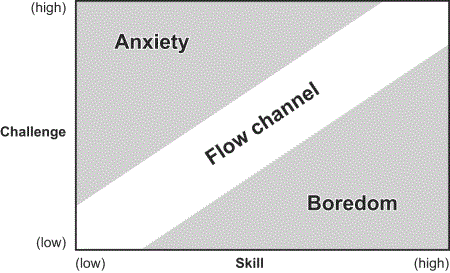Games have always been a replica of our religious understandings, cultural revolution, and cognitive development. Games represent people and their history. They are an integrated part of a society and aid in evaluating the approach and behavior of humans within the society/community.
Though many debates on how games spoil youngsters’ education and their mental health, games just keep growing in numbers and in user base because of its numerous benefits. Games have become a part of people’s lifestyle, be their avatars or their clans.
Games are not being played just because they are amusing. There are various reasons, with the support of psychology, for why people play games. As aspirants of a gaming career, it is important that you understand the psychology of your players and why they play games to deliver them the best suitable games that will be successful in the market for sure.
Evolution of Players:
The early man played games which were luck based, sometimes involving motor skills, and sometimes both, like Tali and Tropa, without using much of strategic thinking.

Tali (Knucklebones); Image courtesy: misfitsandheroes.wordpress.com
Later with the evolution of cognitive thinking, strategy-based games came into existence. Such games paved way for the intellectual gamer community. The ancient games like Chaturanga, Goats and Tigers, Nav Keti Keta, Seega, Quirkat, Calculi, Wei-qi(Go), Hnefatafl, Xiangqi, and Navakankari were completely strategy-based games. The board games like Chess and Snakes and Ladders, which are available now in the market, are inspired by the ancient games like Chaturanga and Vaikuntapali.
In the 1960s, the first video game system was displayed to the public. And the new era of gaming started; and right now, the market is flooded with lots and lots of games, targeting the right players.
The players evolved with the games, whether luck based or complete strategy based games; whether board/card games or video games. As games evolved in different genres to achieve different kinds of fun/pleasures, we had players of different types. Let’s see them in detail.
Kinds of Pleasures a Player Seeks
A game’s success is in its way of giving one of the unique and best experiences for the players. It is just lines of codes and packs of images, videos, and audios if it is not providing that experience to a player. A player plays a game for that experience and he/she experiences certain pleasures. According to Mark LeBlanc, an educator and game designer, game pleasure is classified into 8 kinds. They are Sensation, Fantasy, Narrative, Challenge, Fellowship, Discovery, Expression, and Submission.
To explain the taxonomy in detail, games are being played for the pleasures to the senses, for the pleasure of existing in an illusion world, for the unfolding drama, for the threats and dare, for socializing, for exploring, for expressing oneself, and for killing time.
Certain players prefer certain game pleasures in a game. They admire, pursue and work for those pleasures when playing games and those pleasures act as the motivational factors for the player to play a game. So it is a key to address one or more of the pleasures in your games.
The players, based on their game pleasure preferences, are classified into four types by Richard Bartle.
Types of Players
Richard Bartle, a game researcher, classified players into four types - Killers, Achievers, Socializers, and Explorers, based on their favourite action inside the game. It can be either killing others or solving a puzzle or helping others or finding new things.

Image courtesy: Repignite.com
A player who is of type Killer plays ‘CounterStrike’ game; while a player of type Explorer plays ‘Myst’. The Achiever type prefers ‘Chess’ and the Socializer type prefers ‘Sim City’.
The interesting thing happening in the gaming industry right now is the hybrid genres i.e., the combination of different genres, to serve all types of players. So, there are almost no game sticking to a single genre and every game has something to give to all types of players.
Understanding Players’ Likes and Dislikes
We know what a player wants to do in a game and what a player expects from a game. In addition to that, Players’ likes, dislikes, and characteristics can be understood by classifying players under demographics (external factors), and psychographics (internal factors).
Demographics: Under this, we categorize players based on the market segments, like their age, gender, income, ethnicity, and so on. For example, an infant of age up to 3 will be interested in toys, but not in complex and problem-solving games; whereas, the pre-teens of age group 10-13 go through high neurological growth and expect tough challenges in games.
Also, female and male players may play different types of games with different expectations and may play the same game in different ways. Most females like to experience real-world connection, such as emotions, nurturing, communication, and learning by example; while, most males like to experience achievement, authority, and autonomy.
Based on the cognitive development of the human brain, brain-wiring of the genders and the social structure, players’ likes and dislikes and the characteristics vary. As the result of those, the reasons why they play games change from person to person.
Psychographics: Here, the focus is on the internal factors like personality, values, opinions, attitudes, interests, lifestyles, interests, and behaviors. Players play games that match their interest; as how Football lovers play FPS games. So try to understand your players’ psychographic attributes and design games accordingly.
Players Prefer Balanced Games
Though we have players of different types seeking different pleasures and with different likes and dislikes, balanced games are always welcome by most players. Balanced games refer to the balance between Challenge and Skill, which is one of the great tasks for a game designer; and a game, which when well designed with good balance of the two satisfy its players.
A player plays a game that satisfies his need to be challenged. A kid, with limited mental skills, prefers a game with a high degree of luck than a strategy game. Competitive players prefer games which have limited or no luck and have more elements to advertise their power, skill, and mental ability. So, to attract a wide range of audience, you would have to design a game balancing between challenge and skill.

Image courtesy: jesperjuul.net
An unbalanced game leads the player to boredom, anxiety, confusion, non-engagement and affects the flow of the game. A well-balanced game compels the player to play the game again and again, as that will satisfy certain psychological Needs.
You Give What Your Player Seeks
As you make games for players, you need to understand them thoroughly and that understanding gives you the insight of the players’ psychology. To help a game designer in this, many user research methods like observation methods and interviews are being followed to research on the target audience of your games. However, a player never understands how a game is being made and it is not needed too. They don’t know about balancing a game or adding challenging elements into the game.
She/he always plays a game for the experience. The experience may be scoring high points or being killed by zombies. When they love the experience, they will play the game again and again. So it all comes to the point that, the player should love the experience that is being produced by the game.
So, you give what your player seeks.